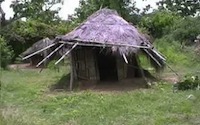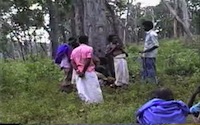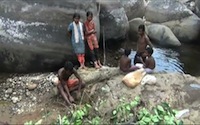The varieties of language spoken by the small groups of Kurumbas scattered on the slopes of the Nilgiri hills and surrounding forested areas in the South of India present, linguistically, numerous points of interest.
The Nilgiri area, spreading at the meeting point of the three southern states of India : Tamil Nadu, Kerala and Karnataka, represents an environmental ‘island’ which remained more or less untouched by the main political, economic and cultural developments which occurred in the surrounding plains until the 20th century. Recognized as the first Unesco Biosphere Reserve of India, the Nilgiri area can also be considered as a linguistic reserve. For a long time, the area was sparsely populated by small groups of tribals, loosely organized into ethnic groups: Kurumbas, Irulas, Paniyas, etc. who relied mainly on natural resources for their living. Interaction with the outside world was kept minimal, typically limited to the exchange of forest products for basic necessities, such as rice and cloth. Occasional war-related intrusions from the surrounding kingdoms occurred in the course of history, but they are poorly documented. All the Nilgiri area languages present very archaic linguistic features as well as traces of -past or recent- influences of the dominant neighbouring languages and independent innovations which make them difficult to classify. The nature based economy of these groups makes them precious for the study of the lexicon of wildlife, flora and fauna.
The administrative modernization and reorganization initiated under the British rule induced the fragmentation of the Nilgiri tribal world and put most of the groups into direct contact with the culture and the language of the state within which they were located.
Sociolinguistically, the languages of the Kurumbas can be characterized as « a transitional boundary, which perpetuates an older dialect continuum overlaid by distinct official languages» as it was proposed by Southworth (ft. 33, p. 286) for other border areas.
All the varieties of Kurumba spoken in the Nilgiri belong to the South-Dravidian group of languages. Geographically, the Dravidian languages are currently concentrated in the four Southern states of India, where the official languages: Tamil in Tamil Nadu, Malayalam in Kerala, Kannada in Karnataka and Telugu in Andhra Pradesh have a long literary tradition spanning over one or two millennia. However, Dravidian vernaculars are also found at the northern corners of the Indian subcontinent: Brahui in the North-West on the Pakistan-Afghanistan border, Kurukh and Malto on North-East borders with Nepal and Bangladesh. The linguistic classification reflects the geographical distribution: North-, Central and South-Dravidian (cf. Krishnamurti 2003). All the literary languages belong to one of the two main branches of this last group, South-Dravidian I for Tamil, Malayalam and Kannada and South-Dravidian II (or South-Central) for Telugu.
Within the South-Dravidian I group, historical data –based on Tamil epigraphic records of the mid-3rd c. BCE– evidence that the two main sub-groups, Tamil and Kannada, had already split at that early date. A key feature of the split is the phonological change of *k- to c- in Tamil. « The Nilgiri languages are all non-palatalizing, unlike Tamil and Malayalam […]. They must have separated from Pre-tamil before the rule of palatalization set in […] » (Krishnamurti 2003:112). Many other features indicate that the Nilgiri languages evolved independently of the two main branches (Tamil and Kannada) from a very early time: maintenance of alveolar/dental distinction, retention of the inclusive/exclusive ‘we’ pronouns, distinct tense systems… One of the most surprising facts encountered in the study of the endangered Nilgiri languages is that they preserve ‘live’ traces of some grammatical and lexical features which are only attested in the earliest records of the literary languages. Their detailed investigation may therefore play an important role in the historical-comparative study.
However, there is not a single shared innovation which would allow setting up a distinct Nilgiri subgroup. As noticed by Zvelebil “[they] have the character of ‘mixed’ languages in the sense that they share various phonological, grammatical, and lexical features with Tamil, Malayalam, and Kannada in an almost “non-systematic” manner which points towards much borrowing and diffusion of features” (1981:523). The same observation can be made for the Kurumba varieties under study: each of them seems to have freely drawn from a pool of South-Dravidian features and arranged them differently in order to set up an independent language. For instance, in Cholanaika there is no variation in persons on the verb –a typical Malayalam feature-, but the phonological change *p > h>Ø –a typical Kannada feature, is also found, as well as in Jenu and Alu Kurumba. On the contrary, in Mullu Kurumba, the most Malayalam-like variety of Kurumba, initial *p— is retained, but the verb form varies in persons as in Alu Kurumba. The centralized vowels, a typical Nilgiri feature also found in Kodagu (Tamil branch) are attested in Jenu Kurumba and Alu Kurumba, but not in the other two varieties. The tense systems of the verbs are also very interesting. Not only do they differ from one variety to the other, but they also differ from the usual Dravidian systems in their forms and structures. For instance, Jēnu Kurumba presents the unique feature of being ‘tenseless’, using the same verb form for present, future or past reference. Alu Kurumba shares with other Nilgiri languages a distinct innovation: the use of the ‘past’ stem for the construction of the Present and Past forms. Mullu Kurumba and Cholanaika have the same three-fold distinction (past-present-future) as the literary languages, but the future tense marker –mu used in Cholanaika is not found in any other South-Dravidian language. One of the linguistic challenges of the documentation will be to evaluate what remains of the older dialect continuum and which of the changes are language specific innovations and which ones are likely to be due to the impact of the state languages.
Recording longer texts may reveal other peculiarities in the language of the Kurumbas. It will also bring richer vocabulary and allow to precise the cultural similarities and differences between the Kurumba groups.
References
Krishnamurti, Bhadriraju. 2003. The Dravidian languages. Cambridge language surveys. Cambridge ; New York: Cambridge University Press.
Southworth, Franklin C. 2005. Linguistic Archaeology of South Asia. London & New-York: Routledge.
Zvelebil, Kamil V. 1981. Problems of identification and classification of some Nilagiri tribes: Irulas-Urali Kattu Nayakes, Jenu Kurumbas, Solegas. Anthropos 76:467-528.








